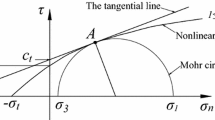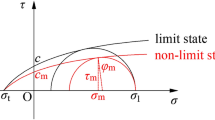Abstract
In this paper, the normal stress distribution function along the failure surface in soil obeying general nonlinear failure criterion is first derived, and then a method for calculating the static and seismic active earth pressure for soils obeying nonlinear failure criteria is proposed. The method proposed yields not only the active earth pressure and its action point, but also the failure surface and the stress distribution along it. Results of the calculated examples by the proposed method are more reasonable than those reported in the literature. The influence of the parameters of the nonlinear failure criterion on the active earth pressures is also investigated.












Similar content being viewed by others
References
Azad A, Yasrobi SS, Pak A (2008) Seismic active pressure distribution history behind rigid retaining walls. Soil Dyn Earthq Eng 28(5):365–375
Baker R (2004) Nonlinear Mohr envelopes based on triaxial data. J Geotech Geoenviron Eng 130(5):498–506
Baker R, Frydman S (1983) Upper bound limit analysis of soil with non-linear failure criterion. Soils Found 23(4):34–42
Balla A (1961) The resistance to breaking out of mushroom foundations for Pylons. In: Proceedings of 5th international conference on soil mechanics and foundation engineering, Paris
Bishop AW, Webb DL, Lewin PI (1965) Undisturbed samples of London Clay from the Ashford Common shaft: strength–effective stress relationships. Geotechnique 15(1):1–31
Caltabiano S, Cascone E, Maugeri M (2012) Static and seismic limit equilibrium analysis of sliding retaining walls under different surcharge conditions. Soil Dyn Earthq Eng 37:38–55
Chen W (1975) Limit analysis and soil plasticity. Elsevier, Amsterdam
Cheng YM (2003) Seismic lateral earth pressure coefficients for c–φ soils by slip line method. Comput Geotech 30(8):661–670
Collins IF, Gunn CIM, Pender MJ, Yan W (1988) Slope stability analyses for materials with a non-linear failure envelope. Int J Numer Anal Methods Geomech 12(5):535–550
Deshmukh VB, Dewaikar DM, Choudhury D (2010) Computations of uplift capacity of pile anchors in cohesionless soil. Acta Geotech 5(2):87–94
Dewaikar DM, Halkude SA (2002) Seismic passive/active thrust on retaining wall-point of application. Soils Found 42(1):9–15
Dewaikar DM, Pandey SR, Dixit J (2012) Active thrust on an inclined retaining wall with inclined cohesionless backfill due to surcharge effect. ISRN Soil Sci 2012:1–8
Fredlund DG, Krahn J, Pufahl DE (1981) The relationship between limit equilibrium slope stability methods. In: Proceedings of the 10th international conference on soil mechanics and foundation engineering, Stockholm
Greco VR (2014) Analytical solution of seismic pseudo-static active thrust acting on fascia retaining walls. Soil Dyn Earthq Eng 57:25–36
Iskander M, Chen ZC, Omidvar M, Guzman I (2013) Rankine pseudo-static earth pressure for c–ϕ soils. Mech Res Commun 51:51–55
Janbu N (1957) Earth pressure and bearing capacity calculations by generalized procedures of slices. In: Proceedings of 4th international conference on soil mechanics and foundation engineering, London
Jiang JC, Baker R, Yamagami T (2003) The effect of strength envelope nonlinearity on slope stability computations. Can Geotech J 40(2):308–325
Kame GS, Dewaikar DM, Choudhury D (2010) Active thrust on a vertical retaining wall with cohesionless backfill. Electron J Geotech Eng 15:1848–1863
Kötter F (1903). Die bestimmung des drucks an gekrümmten gleitflächen, eine aufgabe aus der lehre vom erddruck. In: Sitzungsberichte der Akademie der Wissenschaften, Berlin
Kumar J (2001) Seismic passive earth pressure coefficients for sands. Can Geotech J 38(4):876–881
Kumar J, Chitikela S (2002) Seismic passive earth pressure coefficients using the method of characteristics. Can Geotech J 39(2):463–471
Lancellotta R (2002) Analytical solution of passive earth pressure. Geotechnique 52(8):617–619
Maksimovic M (1989) Nonlinear failure envelope for soils. J Geotech Eng 115(4):581–586
Matsuo M (1967) Study on uplift resistance of footings (I). Soils Found 7(4):1–37
Mononobe N, Matsuo H (1929) On determination of earth pressure during earthquakes. In: Proceedings of the World Engineering Congress, Tokyo
Morrison JEE, Ebeling RM (1995) Limit equilibrium computation of dynamic passive earth pressure. Can Geotech J 32(3):481–487
Okabe S (1924) General theory on earth pressure and seismic stability of retaining walls and dams. J Jpn Soc Civ Eng 10(6):1277–1323
Penman ADM (1953) Shear characteristics of a saturated silt, measured in triaxial compression. Geotechnique 3(8):312–328
Ponce VM, Bell JM (1971) Shear strength of sand at extremely low pressures. J Soil Mech Found Div 97(4):625–638
Rahardjo H, Fredlund DG (1984) General limit equilibrium method for lateral earth force. Can Geotech J 21(6):166–175
Rangari SM, Choudhury D, Dewaikar DM (2013) Estimation of seismic uplift capacity of horizontal strip anchors using pseudo-dynamic approach. KSCE J Civ Eng 17(5):989–1000
Serrano A, Olalla C (1994) Ultimate bearing capacity of rock masses. Int J Rock Mech Min Sci Geomech Abstr 31(2):93–106
Shamsabadi A, Xu S, Taciroglu E (2013) A generalized log-spiral-Rankine limit equilibrium model for seismic earth pressure analysis. Soil Dyn Earthq Eng 49:197–209
Sokolovskii VV (1960) Statics of soil media. Butterworth, London
Sokolovskii VV (1965) Statics of granular media. Pergamon Press, London
Yamaguchi H (1959) A few considerations on the modified Kötter’s equation. Trans Jpn Soc Civ Eng 1959(60):11–19
Yang X (2007) Upper bound limit analysis of active earth pressure with different fracture surface and nonlinear yield criterion. Theor Appl Fract Mech 47(1):46–56
Yang X, Yin J (2005) Upper bound solution for ultimate bearing capacity with a modified Hoek-Brown failure criterion. Int J Rock Mech Min Sci 42(4):550–560
Zakerzadeh N, Fredlund DG, Pufahl DE (1999) Interslice force functions for computing active and passive earth force. Can Geotech J 36(6):1015–1029
Zhang XJ, Chen WF (1987) Stability analysis of slopes with general nonlinear failure criterion. Int J Numer Anal Methods Geomech 11(1):33–50
Acknowledgments
The work reported in this paper is financially supported by the National Key Fundamental Research and Development Program of China (Project No. 2014CB047004).
Author information
Authors and Affiliations
Corresponding author
Appendix: Derivation of Eq. (11)
Appendix: Derivation of Eq. (11)
Equation (8) can be rearranged into a matrix form:
where,
According to the chain rule, the directional derivatives {p s } and {θ s } can be formulated as
where, θ α and θ β are the inclination angles of the α and β line, respectively.Therefore, the derivatives {p x } and {θ x } can be expressed as:
Substituting Eq. (42) for {p x } and {θ x } into Eq. (39), the latter then becomes
Left multiply Eq. (43) by ([J][K θ ]−1) = ([J][K θ ]), the inverse of ([K θ ][J]−1), then we have
where,
In order to decouple the differential equations, we need to make the matrix \( [J][K][J]^{ - 1} \) a diagonal one by choosing suitable direction angles.
Let now the non-diagonal elements are zero
which leads to the following two different inclination angles and consequently gives the characteristic line as shown in Fig. 3.
Substituting Eq. (48) and Eq. (46) in turn into Eq. (44), we can get the Eq. (11).
Rights and permissions
About this article
Cite this article
Sun, Yj., Song, Ex. Active earth pressure analysis based on normal stress distribution function along failure surface in soil obeying nonlinear failure criterion. Acta Geotech. 11, 255–268 (2016). https://doi.org/10.1007/s11440-015-0390-z
Received:
Accepted:
Published:
Issue Date:
DOI: https://doi.org/10.1007/s11440-015-0390-z




